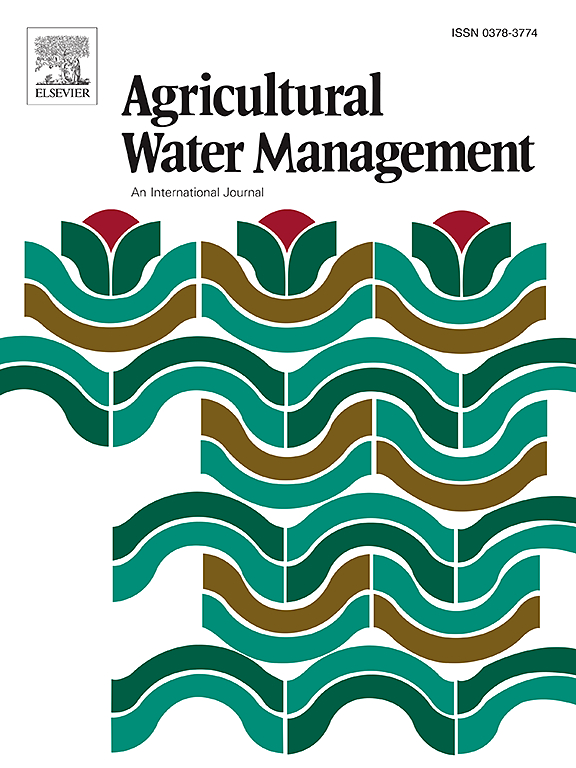Impact of ridge nitrogen and furrow irrigation strategies to evaluation winter wheat production and economic benefits under bed-planting in semi-humid regions
IF 5.9
1区 农林科学
Q1 AGRONOMY
引用次数: 0
Abstract
To further explore the water and nitrogen-saving potential technique under the ridge-nitrogen and furrow irrigation model of winter wheat. The study consists of four nitrogen treatments: F0: no nitrogen; F1: 120 kg N hm−2 (100 % conventional urea); F2: 180 kg N hm−2 (30 % conventional urea and 70 % stabilized urea), and F3: 240 kg N hm−2 (components is same as F2); while three irrigation levels of (I1: 300; I2: 450 and I3: 600 m hm−2) during 2020–2021 and 2021–2022. The results showed that increasing the nitrogen application rate was beneficial to nitrogen uptake, plant growth, and yield formation under the bed planting technique, while the nitrogen application rate exceeded 180 kg ha−1, the grain yield and nitrogen accumulation had no significant increase. The soil moisture at the maturity stage under the ridge cultivation gradually decreases with the increase of nitrogen application. The economic benefits and output-input ratio reached the highest level under the F2I2 treatment. The nitrogen uptake efficiency, nitrogen partial fertilizer productivity, and nitrogen agronomy efficiency under the F2I2 treatment increased by 21.7 %, 29.1 %, and 2.9 % respectively, and the IWUE, PWUE, and WUE increased by 61.0 %, 3.4 %, and 12.3 % compared with conventional practice. The yield, net income, and output-input ratio increased by 5.2 %, 8.3 %, and 20.1 % compared with conventional practice. Therefore, controlled-release urea at the 180 kg N ha−1 and bed planting technique combined with 450 m hm−2 irrigation could improve nitrogen and irrigation use efficiency; maintain high grain yield and economic benefit.
垄氮和沟灌策略对半湿润地区床栽冬小麦产量和经济效益评价的影响
进一步探索冬小麦垄氮沟灌模式下的节水氮潜力技术。研究包括4个氮处理:F0:不施氮;F1: 120 kg N hm−2(100 %常规尿素);F2: 180 kg N hm−2(30 %常规尿素和70 %稳定尿素),F3: 240 kg N hm−2(成分同F2);3个灌溉水平分别为(I1: 300;I2: 450和I3: 600 m hm−2)在2020-2021年和2021-2022年期间。结果表明,增加施氮量有利于氮素吸收、植株生长和产量形成,当施氮量超过180 kg ha−1时,籽粒产量和氮素积累无显著增加。垄作条件下成熟期土壤水分随施氮量的增加而逐渐降低。经济效益和产出投入比在F2I2处理下达到最高水平。F2I2处理的氮素吸收效率、氮素偏肥生产力和氮素农艺效率分别比常规提高了21.7% %、29.1 %和2.9 %,IWUE、PWUE和WUE分别提高了61.0 %、3.4 %和12.3 %。与常规做法相比,产量、净收入和产出投入比分别提高了5.2 %、8.3 %和20.1 %。因此,180 kg N ha - 1控释尿素和床上种植技术配合450 m hm - 2灌溉可提高氮素和灌溉利用效率;保持粮食高产和经济效益。
本文章由计算机程序翻译,如有差异,请以英文原文为准。
求助全文
约1分钟内获得全文
求助全文
来源期刊

Agricultural Water Management
农林科学-农艺学
CiteScore
12.10
自引率
14.90%
发文量
648
审稿时长
4.9 months
期刊介绍:
Agricultural Water Management publishes papers of international significance relating to the science, economics, and policy of agricultural water management. In all cases, manuscripts must address implications and provide insight regarding agricultural water management.
 求助内容:
求助内容: 应助结果提醒方式:
应助结果提醒方式:


